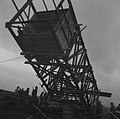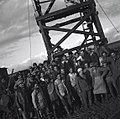Sde Nahum
Sde Nahum
שְׂדֵה נַחוּם | |
|---|---|
 | |
| Etymology: Nahum’s Field | |
 Sde Nahum | |
| Coordinates: 32°31′31.08″N 35°28′54.47″E / 32.5253000°N 35.4817972°ECoordinates: 32°31′31.08″N 35°28′54.47″E / 32.5253000°N 35.4817972°E | |
| Country | |
| District | Northern |
| Council | Valley of Springs |
| Affiliation | Kibbutz Movement |
| Founded | 5 January 1937 |
| Founded by | Sadeh group members |
| Population (2019)[1] | 806 |
| Website | www.sde-nahum.org.il |
Sde Nahum (Hebrew: שְׂדֵה נַחוּם, lit. Nahum Field) is a kibbutz in the Beit She'an Valley in northern Israel. Located around 4 km northwest of Beit She'an, it falls under the jurisdiction of Valley of Springs Regional Council. In 2019 it had a population of 806.[1]
History[]
The kibbutz was founded on 5 January 1937 by members of the Sadeh group from the Mikveh Israel agricultural school, as well as immigrants from Austria, Germany and Poland. It was the third kibbutz established as part of the tower and stockade settlement movement. Initially called "Kibbutz HaSadeh," it was later renamed in honour of Nahum Sokolov, a Hebrew writer and Zionist leader.[citation needed] Ruins of a 5th–6th century Byzantine church has been found in the kibbutz.[citation needed]
The nearby Palestinian village of Saffuriya had been almost emptied of its 4000 inhabitants in July 1948. By early January, 1949, about 500 villagers had filtered back, but "neighbouring settlements coveted Saffuriya lands". The "Northern Front" ordered their eviction, which was carried out the 7th of January 1949. The Saffuriya land was then distributed to its neighbouring Jewish settlements.[2]
In February 1949, 1,500 Dunams of Saffuriya land was given to Sde Nahum.[2]

Sde Nahum day of the Aliyah 1937

Sde Nahum founders 1937

Sde Nahum construction of stockade wall 1937

Sde Nahum wall construction 1937

Sde Nahum 1937

Sde Nahum 1939

Sde Nahum 1939

Sde Nahum 1940

1947 photo of Nahum classroom from Palmach archive
Economy[]
The main economic activity is agriculture but the kibbutz also has a factory for the manufacture of plastic materials and an elderly care facility.
Notable residents[]
- Arieh Warshel, Nobel Prize-winning chemist (2013) and professor at the University of Southern California was born in Sde Nahum in 1937.[3]
References[]
- ^ a b "Population in the Localities 2019" (XLS). Israel Central Bureau of Statistics. Retrieved 16 August 2020.
- ^ a b Morris, B. (2004). The Birth of the Palestinian Refugee Problem Revisited. Cambridge University Press. pp. 516, 517. ISBN 978-0-521-00967-6.
- ^ Gregersen, Erik (November 16, 2018). "Arieh Warshel". Encyclopædia Britannica. Encyclopædia Britannica, Inc. Retrieved April 23, 2019.
External links[]
- Valley of Springs Regional Council
- Kibbutzim
- Kibbutz Movement
- Populated places established in 1937
- Archaeological sites in Israel
- Populated places in Northern District (Israel)
- 1937 establishments in Mandatory Palestine
- Austrian-Jewish culture in Israel
- German-Jewish culture in Israel
- Polish-Jewish culture in Israel










